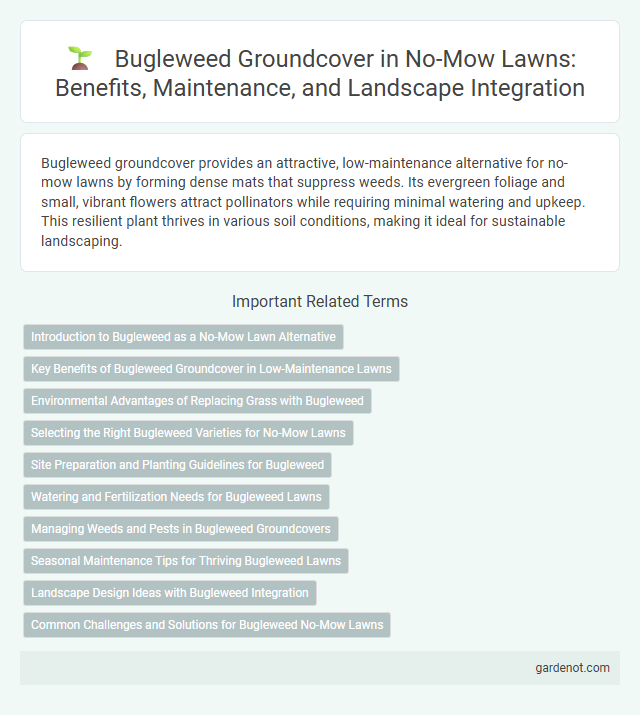Bugleweed groundcover provides an attractive, low-maintenance alternative for no-mow lawns by forming dense mats that suppress weeds. Its evergreen foliage and small, vibrant flowers attract pollinators while requiring minimal watering and upkeep. This resilient plant thrives in various soil conditions, making it ideal for sustainable landscaping.
Introduction to Bugleweed as a No-Mow Lawn Alternative
Bugleweed (Ajuga reptans) serves as an excellent no-mow lawn alternative due to its low-growing, spreading habit and dense groundcover that suppresses weeds. This perennial groundcover thrives in various soil types and shaded conditions, requiring minimal maintenance while providing vibrant blue flowers in spring. Its natural ability to form a thick mat reduces the need for mowing, watering, and fertilizing, making it an eco-friendly substitute for traditional grass lawns.
Key Benefits of Bugleweed Groundcover in Low-Maintenance Lawns
Bugleweed groundcover enhances low-maintenance lawns by providing dense, evergreen coverage that suppresses weeds and reduces soil erosion. Its ability to thrive in shade and tolerate drought conditions minimizes the need for frequent watering and mowing. This resilient plant also supports pollinators, promoting biodiversity in sustainable lawn ecosystems.
Environmental Advantages of Replacing Grass with Bugleweed
Bugleweed groundcover significantly reduces water consumption compared to traditional grass lawns, conserving valuable resources and lowering irrigation needs. Its dense matting suppresses weed growth naturally, minimizing the use of chemical herbicides and promoting healthier soil ecosystems. By enhancing habitat diversity, Bugleweed supports pollinators and beneficial insects, contributing to increased local biodiversity and environmental resilience.
Selecting the Right Bugleweed Varieties for No-Mow Lawns
Choosing the right Bugleweed variety for no-mow lawns depends on factors like growth habit, shade tolerance, and hardiness zones 3-8. Varieties such as Ajuga reptans 'Bronze Beauty' and 'Mahogany' offer low-growing, dense coverage with attractive foliage, reducing maintenance needs. Prioritizing disease-resistant and drought-tolerant cultivars ensures long-lasting groundcover that suppresses weeds and thrives with minimal mowing.
Site Preparation and Planting Guidelines for Bugleweed
Choose a well-drained site with partial to full shade for optimal Bugleweed groundcover growth, ensuring soil is rich in organic matter and slightly acidic to neutral (pH 6.0-7.0). Prepare the area by removing existing vegetation, loosening the soil to a depth of 6-8 inches, and incorporating compost or aged manure to improve fertility and drainage. Plant Bugleweed plugs or division pieces 12-18 inches apart in early spring or fall, keeping roots moist and covering lightly with soil to encourage rapid establishment and minimize weed competition.
Watering and Fertilization Needs for Bugleweed Lawns
Bugleweed lawns require moderate watering, typically 1 inch per week, ensuring the soil remains consistently moist but not waterlogged. Fertilization needs are low, with a balanced, slow-release fertilizer applied once in early spring promoting healthy growth and vibrant groundcover. Over-fertilizing can encourage unwanted weed growth and diminish the plant's natural drought tolerance, making careful nutrient management essential.
Managing Weeds and Pests in Bugleweed Groundcovers
Bugleweed groundcovers suppress weed growth by creating a dense mat that shades out invasive species and reduces bare soil exposure. Regular monitoring for common pests such as aphids and spider mites helps prevent infestations, with insecticidal soaps or neem oil serving as eco-friendly treatment options. Effective management combines proper spacing, adequate watering, and organic mulching to maintain robust plant health and natural pest resistance.
Seasonal Maintenance Tips for Thriving Bugleweed Lawns
Bugleweed groundcover thrives with minimal mowing and requires seasonal maintenance to ensure dense, healthy coverage. In spring, apply a balanced fertilizer and prune back any dead growth to encourage vigorous new shoots. During summer, ensure consistent moisture without waterlogging and trim lightly to control spread and promote a lush carpet.
Landscape Design Ideas with Bugleweed Integration
Bugleweed groundcover enhances no-mow lawn designs by providing dense, low-maintenance foliage that suppresses weeds and reduces soil erosion. Its vibrant green leaves and purple flowers create visually appealing texture contrasts, perfect for borders, slopes, and shaded garden areas. Integrating Bugleweed with native shrubs and perennial blooms supports biodiversity while minimizing lawn upkeep.
Common Challenges and Solutions for Bugleweed No-Mow Lawns
Bugleweed groundcover in no-mow lawns often faces common challenges such as susceptibility to root rot and competition from invasive weeds. Effective solutions include improving soil drainage and applying organic mulch to suppress weed growth while retaining moisture. Regular monitoring and targeted use of organic fungicides can also prevent disease outbreaks and maintain a healthy Bugleweed carpet.
Bugleweed groundcover Infographic

 gardenot.com
gardenot.com